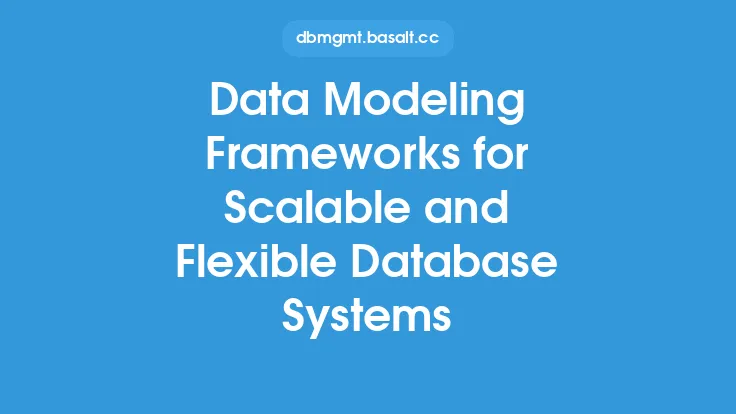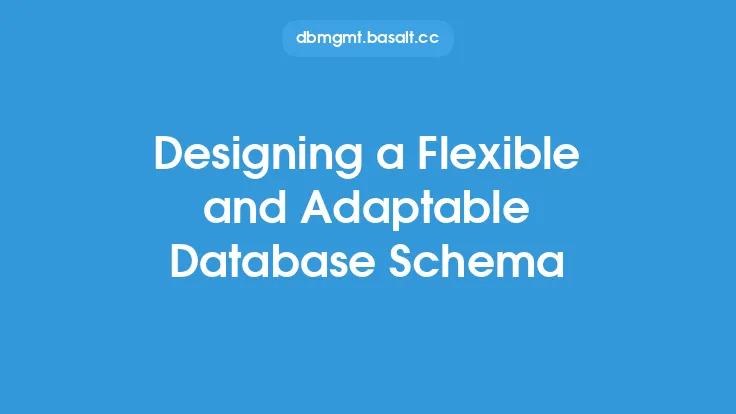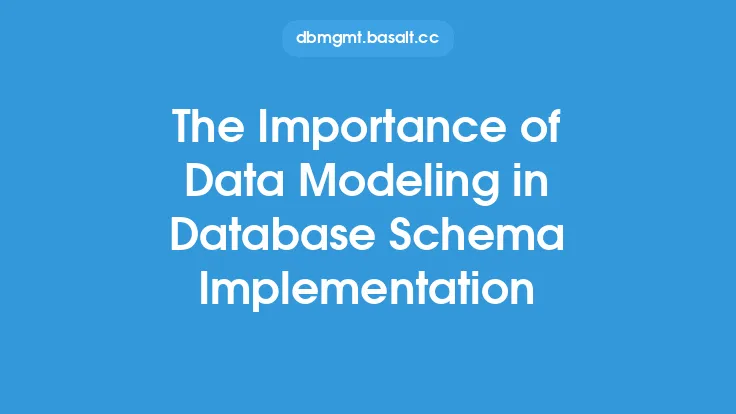When designing a database, one of the most critical aspects to consider is the flexibility of the schema. A flexible database schema is essential for adapting to changing business requirements, new data sources, and evolving user needs. Data modeling principles play a crucial role in creating a flexible database schema. In this article, we will delve into the principles of data modeling that enable the creation of a flexible database schema, allowing organizations to respond quickly to changing circumstances.
Introduction to Flexible Database Schema
A flexible database schema is one that can accommodate changes in the structure and relationships of the data without requiring significant modifications to the underlying database design. This flexibility is critical in today's fast-paced business environment, where new applications, services, and data sources are constantly being introduced. A flexible database schema enables organizations to integrate new data sources, add new features, and adapt to changing business requirements without disrupting existing operations.
Principles of Flexible Data Modeling
To create a flexible database schema, data modelers must adhere to several key principles. These principles include:
- Separation of Concerns: Separate the data model into distinct layers, each addressing a specific aspect of the data, such as structure, relationships, and constraints. This separation enables changes to be made to one layer without affecting the others.
- Data Abstraction: Abstract the data model from the physical storage and implementation details, focusing on the logical structure and relationships of the data. This abstraction enables the data model to be applied to different physical storage systems and platforms.
- Data Normalization: Normalize the data model to minimize data redundancy and dependency, ensuring that each piece of data is stored in one place and one place only. This normalization enables changes to be made to the data model without introducing data inconsistencies.
- Data Generalization: Generalize the data model to accommodate multiple related concepts and entities, rather than creating separate models for each. This generalization enables the data model to adapt to changing business requirements and new data sources.
Data Modeling Techniques for Flexibility
Several data modeling techniques can be employed to create a flexible database schema. These techniques include:
- Entity-Relationship Modeling: Use entity-relationship modeling to identify and define the key entities, attributes, and relationships in the data model. This technique enables the creation of a flexible data model that can accommodate changing business requirements and new data sources.
- Object-Role Modeling: Use object-role modeling to define the roles and relationships between entities in the data model. This technique enables the creation of a flexible data model that can accommodate complex relationships and changing business requirements.
- Dimensional Modeling: Use dimensional modeling to create a data model that is optimized for data analysis and reporting. This technique enables the creation of a flexible data model that can accommodate changing business requirements and new data sources.
Best Practices for Flexible Data Modeling
To ensure the creation of a flexible database schema, data modelers should adhere to several best practices. These best practices include:
- Keep it Simple: Keep the data model simple and intuitive, avoiding unnecessary complexity and ambiguity.
- Use Standardized Naming Conventions: Use standardized naming conventions to ensure consistency and clarity in the data model.
- Document the Data Model: Document the data model thoroughly, including entity descriptions, attribute definitions, and relationship explanations.
- Test and Validate the Data Model: Test and validate the data model to ensure it meets the required business needs and is free from errors and inconsistencies.
Tools and Technologies for Flexible Data Modeling
Several tools and technologies are available to support flexible data modeling. These tools and technologies include:
- Data Modeling Software: Use data modeling software, such as Entity-Relationship Diagram (ERD) tools, to create and manage the data model.
- Database Management Systems: Use database management systems, such as relational databases or NoSQL databases, to implement and manage the flexible database schema.
- Data Integration Tools: Use data integration tools, such as Extract, Transform, Load (ETL) tools, to integrate data from multiple sources and create a unified view of the data.
Conclusion
Creating a flexible database schema is critical for adapting to changing business requirements, new data sources, and evolving user needs. By adhering to key principles, such as separation of concerns, data abstraction, data normalization, and data generalization, data modelers can create a flexible data model that enables the creation of a flexible database schema. By employing data modeling techniques, such as entity-relationship modeling, object-role modeling, and dimensional modeling, and following best practices, such as keeping it simple, using standardized naming conventions, documenting the data model, and testing and validating the data model, organizations can ensure the creation of a flexible database schema that meets their changing needs.





